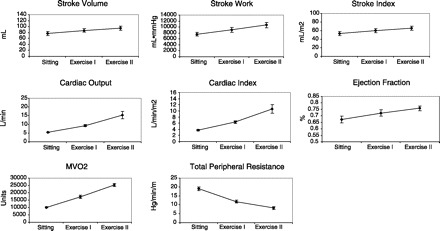Fig. 7.

Calculated values. Stroke volume, stroke index, stroke work, cardiac output, cardiac index, and cardiac work (not shown) all (n = 10 students) increased during exercise. Of note, the increase in cardiac output from 5 to 10 to 15 l/min fitted well with values used in lectures and textbooks for moderate levels of exercise. MV̇o2 increased, reinforcing the concept that increased cardiac work is supported by increased metabolism. This also evolved into a discussion that because of a near-maximal oxygen extraction at rest in the heart, coronary blood flow must increase, especially during increased work states, such as exercise. Total peripheral resistance fell during exercise, reflecting increased blood flow to skeletal muscle and the heart.
